Explore Yichang - China Travel, Asia
Nestled in the heart of Hubei Province, Yichang stands as a vibrant gateway to China's natural and cultural heritage. This city, often referred to as the "Gateway to the Three Gorges," offers a unique blend of historical charm and modern appeal. Yichang is renowned for its picturesque landscapes, rich history, and warm hospitality, making it a must-visit destination for travelers exploring China. Whether you're drawn by the awe-inspiring Three Gorges Dam or the cultural vibrancy of local festivals, Yichang promises an unforgettable experience.
Population: Approximately 4 million in 2020.
Economy: The economy hub in the western of Hubei province with the dominant industries are shipping and shipbuilding.
Landmarks: Famous for the Gezhouba Dam, Three Gorges Dam-the world largest hydroelectric power station, and Shennongjia Forest Area.
China

Overview of Yichang
History & Culture Influence
Yichang boasts a long and storied history, dating back over 2,700 years. As an ancient city, it has played an important role in China's development, particularly as a key port along the Yangtze River. The rich culture of Yichang is heavily influenced by the Tujia ethnic group, one of China's recognized ethnic minorities. The Tujia people have preserved their unique traditions, from folk songs to intricate embroidery, adding a rich cultural tapestry to the city. Visiting Yichang offers a chance to explore this heritage, providing insight into the customs and traditions that have shaped the region.
Interaction with The Locals
Yichang is home to approximately 4 million residents. The city’s population is a diverse mix, with a significant number of Han Chinese and ethnic minorities, including the Tujia people. Yichang's citizens are known for their warm hospitality and strong sense of community. This blend of cultures contributes to the city's vibrant local life, where traditional customs coexist with modern lifestyles.
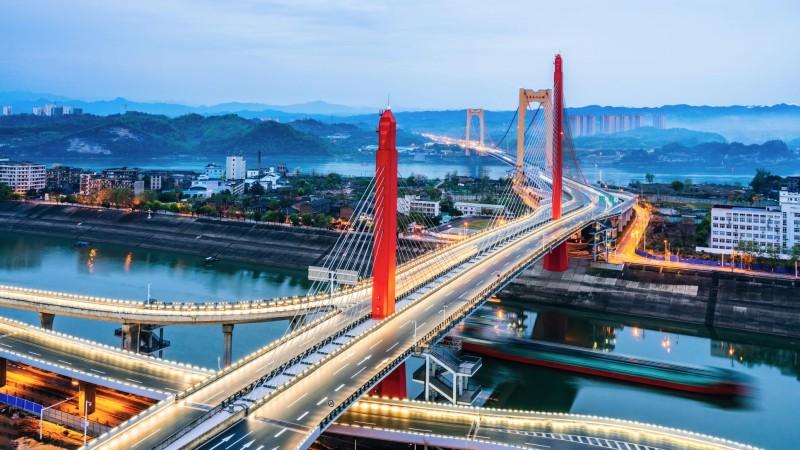
Yichang, Hubei Province - © Facts.net
Top Attractions in Yichang
- Three Gorges Dam: The Three Gorges Dam is Yichang's most iconic landmark and a marvel of modern engineering. As the world's largest hydroelectric power station, it offers breathtaking views and fascinating insights into China's technological advancements. Visitors can explore the dam's observation points, museums, and surrounding scenic areas, making it a must-see attraction in Yichang.
- Gezhouba Dam: Another significant site is the Gezhouba Dam, an earlier but equally impressive engineering feat. It was the first large-scale dam built on the Yangtze River and remains an essential part of the region's infrastructure. The Gezhouba Dam area also offers beautiful natural scenery, including lush parks and peaceful river views.
- Sanyou Cave: For a taste of Yichang's natural beauty and cultural history, Sanyou Cave is an excellent destination. This cave is famous for its stunning rock formations and ancient inscriptions. It is said that three famous poets from the Tang Dynasty visited this site, leaving behind writings that add to its historical allure. The cave's serene environment and historical significance make it a popular spot for both nature lovers and history enthusiasts.
- Yiling Square: Yiling Square is a bustling urban hub that serves as a focal point for locals and visitors alike. Surrounded by shops, restaurants, and cultural institutions, the square is an excellent place to experience Yichang's modern vibe. It also presents a range of cultural events and shows that offer an insight into the modern art scene in the city.
- Shennongjia Forest Area: A UNESCO World Heritage Site, the Shennongjia Forest Area is a vast nature reserve known for its diverse flora and fauna. It's a paradise for hikers and nature enthusiasts, offering breathtaking landscapes, rare wildlife, and numerous trails. The area is also steeped in legends and folklore, adding a mystical element to its natural beauty.
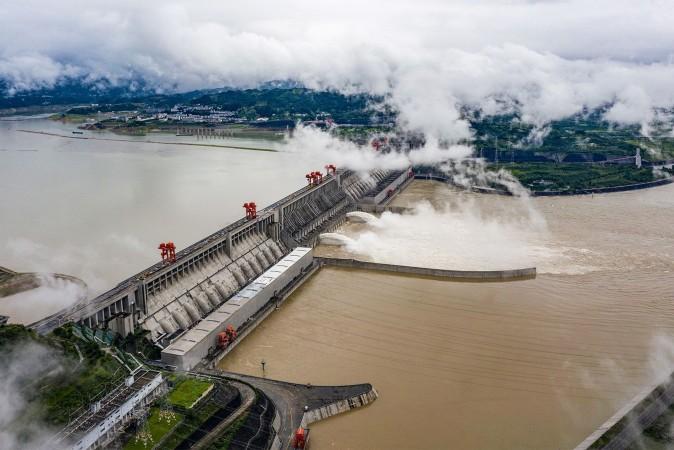
Three Gorges Dam - © CNN
Must-Try Dishes in Yichang
Yichang offers a delightful culinary journey that showcases the rich flavors and traditions of Hubei cuisine. The following meals are a must-try and showcase the city's distinct culinary heritage:
- Yichang Fish Cake: A local specialty, Yichang Fish Cake is made from fresh fish, minced and mixed with seasonings, then shaped into cakes and fried. The result is a crispy fish cake outside and a soft, tasty within. It's often served with a tangy dipping sauce, making it a favorite among both locals and visitors.
- Tujia-style Hot Pot: Experience the warmth of Tujia hospitality with Tujia-style Hotpot, a traditional dish featuring a bubbling pot of rich broth filled with meats, vegetables, and tofu. What sets this hotpot apart is the use of local herbs and spices, which add a distinctive flavor. It's a communal dish, perfect for sharing with friends and family.
- Steamed Glutinous Rice with Ribs: A comforting dish, Steamed Glutinous Rice with Ribs combines tender pork ribs with sticky rice, steamed together with a variety of aromatic spices. This dish is hearty and satisfying, with the rice absorbing the flavors of the meat and spices, creating a deliciously rich taste.
- Doupi (Bean Skin Roll): Doupi, or Bean Skin Roll, is a popular street food in Yichang. It consists of a thin layer of bean curd skin wrapped around a filling of glutinous rice, mushrooms, and sometimes minced pork. The roll is then pan-fried until crispy. It's a perfect snack or a light meal, showcasing the local love for creative, flavorful dishes.
- Xiahe Fish: Xiahe Fish is a Yichang specialty known for its tender and delicate flavor. The dish features fresh fish from the Xiahe River, cooked in a savory sauce with ginger, garlic, and green onions. The simplicity of the ingredients allows the natural taste of the fish to shine, making it a must-try for seafood lovers.
- Braised Pork Belly: Yichang's version of Braised Pork Belly is a rich and savory dish that showcases the local love for hearty flavors. The pork belly is slow-cooked with soy sauce, sugar, and a blend of aromatic spices until it becomes tender and flavorful. It's often served with steamed rice or buns, making it a comforting and filling dish.
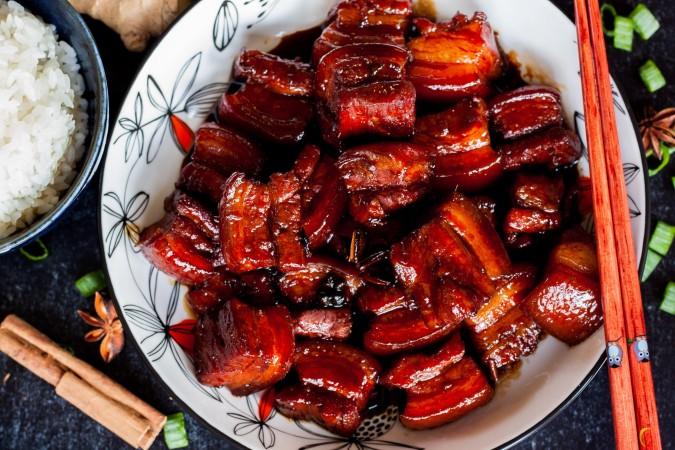
Braised Pork Belly - © The Mini Chef
Festivals & Local Celebrations
Yichang is a city that loves to celebrate its rich cultural heritage through various festivals and events. These celebrations offer a glimpse into the traditions and communal spirit of the local people.
Dragon Boat Festival
The Dragon Boat Festival is one of the most vibrant celebrations in Yichang, held annually in honor of the ancient poet Qu Yuan. The festival features dragon boat races on the Yangtze River, where teams paddle in beautifully decorated boats to the beat of drums. It's a lively event filled with excitement and cultural significance, also marked by the consumption of zongzi, a traditional sticky rice dumpling.
Tujia Ethnic Festivals
The Tujia ethnic group, a significant cultural presence in Yichang, celebrates a variety of unique festivals. One such event is the Sheba Festival, a traditional gathering that includes folk dancing, singing, and ceremonies to honor ancestors. These festivals are vibrant displays of Tujia customs and are a wonderful opportunity for visitors to experience local traditions.
Lantern Festival
The Lantern Festival marks the end of the Chinese New Year celebrations and is celebrated with great enthusiasm in Yichang. The city is adorned with beautiful lanterns, and people gather to watch traditional performances, eat tangyuan (sweet rice balls), and enjoy fireworks. This festival symbolizes the arrival of spring and the reunion of family and friends.
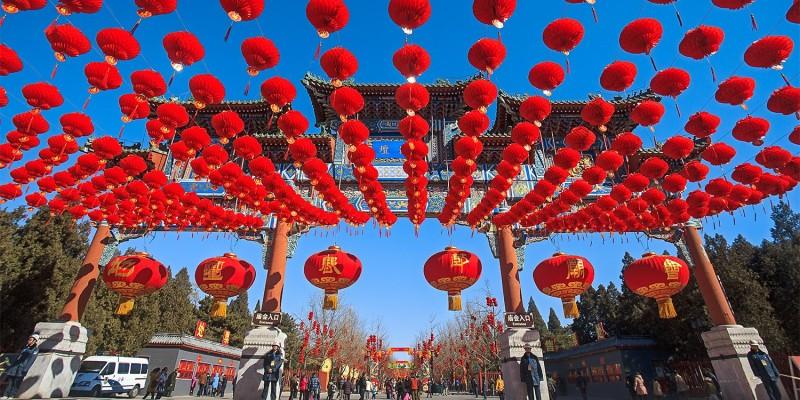
Yichang Lantern Festival - © VietnamNet
What to Do in Yichang
Yichang offers a wide range of activities for tourists, from exploring natural wonders to engaging in cultural experiences. Here's a glimpse of what you can do in this captivating city:
- Yangtze River Cruises: A Yangtze River cruise is a must-do activity when visiting Yichang. These cruises offer breathtaking views of the river's iconic landscapes, including the Three Gorges.
- Hiking and Outdoor Adventures: For nature enthusiasts, Yichang offers excellent hiking opportunities. The Shennongjia Forest Area is a popular destination for trekking, known for its diverse flora and fauna. Additionally, the nearby Three Gorges area offers scenic trails that provide spectacular views of the gorges and the Yangtze River.
- Traditional Chinese Tea Ceremonies: Yichang's tea culture is deeply rooted in its history, and attending a tea ceremony offers insight into the art of tea-making and the social customs surrounding it. It's a peaceful and educational experience that highlights the importance of tea in Chinese culture.
- River Rafting and Water Sports: For those seeking adventure, Yichang's rivers provide excellent opportunities for water sports. River rafting, especially in the more turbulent sections of the Yangtze, offers an exhilarating experience. Kayaking and paddleboarding are also popular activities, allowing visitors to enjoy the river's beauty from a unique perspective.
Shopping in Yichang
- Yichang Night Market: For a lively and authentic shopping experience, visit the Yichang Night Market. This vibrant spot is perfect for picking up unique souvenirs like Tujia ethnic crafts and street food. The vibrant ambiance of the market provides a glimpse of the creativity and culture of the area.
- Wanda Plaza: One of the best places to shop in the city is Wanda Plaza, which has both domestic and foreign brands. With its wide range of stores, dining options, and entertainment facilities, it's ideal for a comprehensive shopping experience.
- Yiling Square Shopping Mall: Located centrally, Yiling Square Shopping Mall offers fashion, electronics, and home goods. It's a great place to explore local and international brands, with plenty of cafes and restaurants for a relaxing break.
- Specialty Tea Shops: Explore Yichang's tea culture by visiting specialty tea shops. These stores offer high-quality local teas like Yichang Maojian and provide insights into traditional tea-making practices.
- Traditional Chinese Medicine Stores: Visit your local businesses that sell herbal cures and health goods to learn about traditional Chinese medicine. It's a unique chance to learn about traditional practices and find natural health products.
- Local Food Markets: Experience Yichang’s culinary delights at local food markets. Purchase fresh produce, regional specialties, and local snacks like dried river shrimp and noodles, offering a taste of Yichang's vibrant food culture.
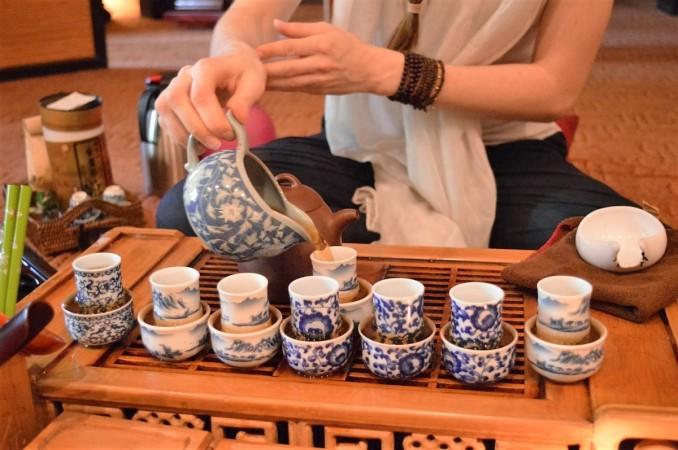
Experience Chinese tea ceremony - © UP FOR A CUP
Weather in Yichang: Best Time to Visit
Yichang experiences a subtropical climate with distinct seasons, influencing the tourism trends throughout the year. Here’s a breakdown of the weather and what to expect in each season:
Spring in Yichang
Spring in Yichang is mild and pleasant, with temperatures ranging from 10°C to 22°C (50°F to 72°F). This season is ideal for outdoor activities, as the weather is comfortable and the natural scenery is lush and blooming. It’s a popular time for tourists to visit, especially for exploring the Yangtze River, enjoying river cruises, and taking in the vibrant natural landscapes. The mild temperatures also make it a great season for hiking and visiting local attractions.
Summer in Yichang
Summer in Yichang can be hot and humid, with temperatures often reaching 25°C to 35°C (77°F to 95°F). This season also marks the rainy period, with frequent showers and high humidity. Despite the heat, summer is a peak time for river cruises on the Yangtze River, as the lush surroundings are at their greenest. Visitors also flock to local festivals and outdoor activities, making it a vibrant season for experiencing Yichang's cultural events and natural beauty.
Autumn in Yichang
Autumn brings cooler temperatures, ranging from 15°C to 25°C (59°F to 77°F). The weather is generally dry and clear, making it an excellent time for sightseeing and outdoor exploration. This season sees a drop in tourist numbers, offering a more relaxed experience at popular attractions. The fall foliage adds a picturesque quality to the city’s landscapes, making it a favored time for photographers and nature lovers.
Winter in Yichang
Winter in Yichang is relatively mild, with temperatures ranging from 5°C to 15°C (41°F to 59°F). While it is cooler, it rarely snows, and the weather remains suitable for travel. Winter is a quieter time for tourism, offering a peaceful atmosphere to explore the city’s attractions without the crowds. It's an ideal season for enjoying indoor activities, visiting museums, and experiencing the local cuisine in a cozy setting.
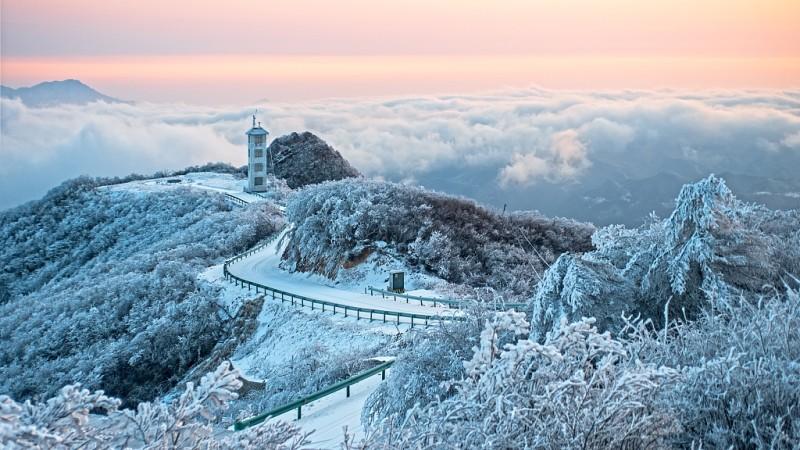
Winter in Yichang - © CGTN
Essential Travel Information
Getting Around Yichang
Yichang offers a range of transportation options to help you explore the city and its surroundings efficiently:
- Public Transit: Yichang has a well-developed public transportation system, including buses and a metro line. The city’s bus network covers major attractions and neighborhoods, while the metro provides a quick and convenient way to travel within the city.
- Taxis and Ride-Sharing: In Yichang, taxis are widely accessible and provide a practical means of transportation across the city. Ride-sharing apps are also popular, providing an alternative to traditional taxis. To help in communication with drivers, make sure the destination is stated in Chinese.
- Bicycles and E-Scooters: For a more flexible and eco-friendly option, consider renting bicycles or e-scooters. Many areas in Yichang have dedicated lanes for cycling, and renting these modes of transport allows you to explore the city at your own pace.
- Trains and Buses for Regional Travel: To explore beyond Yichang, you can take trains or long-distance buses to nearby cities and attractions. The Yichang Railway Station connects to major cities like Wuhan and Chongqing, while buses offer routes to scenic areas and neighboring provinces.
ATM & Banking Services
Accessing banking services in Yichang is convenient with numerous ATMs available throughout the city, including at shopping centers and tourist spots. These ATMs provide multilingual services and accept foreign credit cards. For banking needs such as currency exchange and cash withdrawals, several banks are open from Monday to Friday, with some branches open on Saturdays. Currency exchange services can also be found at hotels and dedicated counters. Most establishments accept major credit and debit cards, but it's a good idea to carry some cash for smaller vendors and markets where card payments may not be accepted.
Where to Stay in Yichang
Yichang offers a range of accommodation options to suit different preferences and budgets:
- Luxury Hotels: These places include upscale features including tasteful eating options, luxurious accommodations, and first-rate service. They are well-located for easy access to major attractions and offer stunning views of the Yangtze River.
- Mid-Range Hotels: There are numerous mid-range hotels in Yichang that provide comfort and value for money where you can experience comfortable rooms, modern amenities, and convenient locations, making them suitable for both leisure and business travelers.
- Budget Accommodation: For budget-conscious travelers, Yichang has various hostels and guesthouses with affordable rates with basic amenities. For tourists seeking affordable, basic lodging, these choices are perfect.
- Boutique Hotels: Yichang also features charming boutique hotels that offer a unique and personalized stay. These places provide distinctive décor, local charm, and a more intimate atmosphere, perfect for travelers seeking a special experience.
Articles for you

Explore Yala National Park - Sri Lanka Travel, Asia
Tucked away in Sri Lanka’s southeastern corner, Yala National Park is where wild nature meets deep tradition. Known worldwide for its leopard population, the park is also home to elephants, sloth bears, crocodiles, and hundreds of bird species. Beyond wildlife, Yala opens doors to a cultural landscape dotted with ancient temples, Buddhist ruins, and coastal villages. For travelers seeking more than just a safari, Yala offers a chance to explore eco-tourism, local communities, and sacred heritage sites.
Population: The Yala National Park area doesn’t have a human population.
Economy: The economy around Yala National Park thrives on a blend of eco-tourism, agriculture, and local services. Safari tours, eco-lodges, and cultural experiences drive steady income for nearby towns like Tissamaharama and Kataragama, supporting thousands of families.
Landmarks: Famous for Block I of Yala and wildlife encounters, including elephants, sloth bears, crocodiles, and exotic bird species.

Explore Galle - Sri Lanka Travel, Asia
Nestled on Sri Lanka’s southern coastline, Galle is a vibrant city where history meets the sea. Its cobbled streets, colonial architecture, and serene beaches make it a must-visit destination for travelers seeking a blend of culture, adventure, and relaxation. A UNESCO World Heritage site, Galle captivates visitors with its Dutch Fort, bustling markets, and friendly locals. Whether you’re exploring the ramparts at sunset or savoring fresh seafood by the shore, Galle promises an unforgettable journey into Sri Lanka’s heritage.
Population: Approximately 113,000 in 2023.
Economy: Galle’s economy thrives on tourism, trade, and fisheries. The city’s historic fort, colonial architecture, and coastal charm draw thousands of international visitors each year, making tourism its main economic driver. Fishing remains vital for local livelihoods, supplying fresh seafood across the region.
Landmarks: Famous for the Galle Fort, Dutch Reformed Church & Maritime Museum, and Unawatuna Beach.

Explore Bentota - Sri Lanka Travel, Asia
Nestled along Sri Lanka’s southwestern coast, Bentota is a tropical paradise that blends golden beaches, vibrant culture, and thrilling adventures. Famous for its calm waters, luxury resorts, and scenic river estuary, Bentota has become a top destination for travelers seeking both relaxation and authentic experiences. From serene beach walks at sunrise to adrenaline-pumping water sports, this coastal town offers a perfect balance of leisure and exploration. With its proximity to Colombo and Galle, Bentota is easy to reach, making it an ideal stop for both short escapes and extended holidays.
Population: Approximately 37,000 in 2023.
Economy: Bentota’s economy thrives mainly on tourism, which drives local businesses such as hotels, restaurants, and wellness retreats. The town also benefits from fishing, coconut cultivation, and handicrafts like wood carving and batik textiles. Many residents rely on the growing demand for water sports and Ayurvedic treatments, making tourism the backbone of both income and employment in the area.
Landmarks: Famous for Bentota Beach, Bentota River Safari, and Kande Vihara Temple.

Explore Mirissa - Sri Lanka Travel, Asia
Mirissa is a charming coastal town on Sri Lanka’s southern shoreline. Known for its golden beaches, turquoise waters, and vibrant marine life, it has become a must-visit stop for travelers exploring the island. Many come for whale watching, surfing, and sunset views at Coconut Tree Hill, but Mirissa offers much more than postcard beauty. The fishing boats you see anchored by the bay carry generations of stories. Local traditions, delicious cuisine, and a laid-back rhythm of life shape every visitor’s experience.
Population: Approximately 4,700 in 2023.
Economy: Mirissa’s economy is largely shaped by its coastal location. Fishing has long been the backbone of local livelihoods, with generations relying on the Indian Ocean for income. In recent decades, tourism has become the main driver of growth, thanks to whale watching, surfing, and beachside hospitality.
Landmarks: Famous for Mirissa Beach, Coconut Tree Hill, and Parrot Rock Bridge.

Explore Nuwara Eliya - Sri Lanka Travel, Asia
Tucked away in the Central Highlands of Sri Lanka, Nuwara Eliya is often called “Little England”. With its rolling tea plantations, cool misty mornings, and colonial charm, this mountain town feels like a step into another world. Travelers come here to breathe fresh air, walk through flower gardens, sip the finest Ceylon Tea, and enjoy a pace of life far from the island’s busy cities. Whether you’re drawn by scenic landscapes, heritage architecture, or the warmth of its people, Nuwara Eliya is a destination that blends nature, culture, and history in perfect harmony.
Population: Approximately 781,000 in 2023.
Economy: Nuwara Eliya’s economy thrives mainly on tea production, as it sits in the heart of Sri Lanka’s central highlands, famous worldwide for Ceylon Tea. The city also benefits from a growing tourism industry, attracting visitors with its colonial charm, cool climate, and scenic landscapes.
Landmarks: Famous for Gregory Lake, Hakgala Botanical Garden, and Victoria Park.

Explore Sukau - Malaysia Travel, Asia
Nestled on the banks of the Kinabatangan River in Sabah, Malaysian Borneo, Sukau is a destination where wildlife, culture, and conservation come together. Known as one of Asia’s top spots for river safaris and eco-tourism, this quiet village offers a front-row seat to encounters with Bornean orangutans, pygmy elephants, proboscis monkeys, and exotic birdlife.
Population: Approximately 1,400 in 2019.
Economy: Sukau’s economy is shaped by its riverine location and natural resources. Traditionally, the Orang Sungai community relied on fishing, small-scale farming, and forest gathering for their livelihood. Today, the village has shifted toward eco-tourism, with river cruises, jungle trekking, and homestays providing income.
Landmarks: Famous for the Kinabatangan River cruises, Gomantong Caves, and Ox-bow lakes and wetlands.
